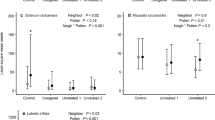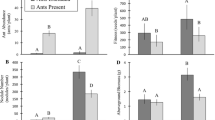Abstract
Many species, both plants and animals, are simultaneously engaged in interactions with multiple mutualists. However, the extent to which separate traits that attract different mutualist guilds display negative or positive relationships remains largely unstudied. We asked whether correlations exist among extrafloral nectary traits to attract arthropod bodyguards and floral traits to attract pollinator mutualists. For 37 species in the cotton genus (Gossypium), we evaluated correlations among six extrafloral nectary traits and four floral traits in a common greenhouse environment, with and without correction for phylogenetic non-independence. Across Gossypium species, greater investment in extrafloral nectary traits was positively correlated with greater investment in floral traits. Positive correlations remained after accounting for the evolutionary history of the clade. Our results demonstrate that traits to maintain multiple mutualist guilds can be positively correlated across related species and build a more general understanding of the constraints on trait evolution in plants.


Similar content being viewed by others
References
Agrawal AA (2011) Current trends in the evolutionary ecology of plant defense. Funct Ecol 25:420–432
Agrawal A, Fishbein M (2006) Plant defense syndromes. Ecology 87:S132–S149
Agrawal AA, Fishbein M, Halitschke R, Hastings AP, Rabosky DL, Rasmann S (2009a) Evidence for adaptive radiation from a phylogenetic study of plant defenses. Proc Natl Acad Sci USA 106:18067–18072
Agrawal AA, Salminen JP, Fishbein M, Tiffin P (2009b) Phylogenetic trends in phenolic metabolism of milkweeds (Asclepias): evidence for escalation. Evolution 63:663–673
Benitez-Vieyra S, Medina A, Glinos E, Cocucci A (2006) Pollinator-mediated selection on floral traits and size of floral display in Cyclopogon elatus, a sweat-bee pollinated orchid. Funct Ecol 20:948–957
Brody AK, Mitchell R (1997) Effects of experimental manipulation of inflorescence size on pollination and pre-dispersal seed predation in the hummingbird-pollinated plant Ipomopsis aggregata. Oecologia 110:86–93
Bronstein JL (1994) Our current understanding of mutualism. Q Rev Biol 69:31–51
Cahill JF, Elle E, Smith GR, Shore BH (2008) Disruption of a belowground mutualism alters interactions between plants and their floral visitors. Ecology 89:1791–1801
Cavender-Bares J, Ackerly DD, Baum DA, Bazzaz FA (2004) Phylogenetic overdispersion in Floridian oak communities. Am Nat 163:823–843
Chen ZJ et al (2007) Toward sequencing cotton (Gossypium) genomes. Plant Physiol 145:1303–1310
Clark KR, Gorley RN (2007) Primer, version 6.1.10, user manual and tutorial. Primer-E, Plymouth
Clarke KR (1993) Non-parametric multivariate analyses of changes in community structure. Aust J Ecol 18:117–143
Dejoode D, Wendel J (1992) Genetic diversity and origin of the Hawaiian Islands cotton, Gossypium tomentosum. Am J Bot 79:1311–1319
Eckstein RL, Karlsson PS, Weih M (1999) Leaf life span and nutrient resorption as determinants of plant nutrient conservation in temperate-arctic regions. New Phytol 143:177–189
Felsenstein J (2008) Comparative methods with sampling error and within-species variation: contrasts revisited and revised. Am Nat 171:713–725
Fritz RS, Morse DH (1981) Nectar parasitism of Asclepias syriaca by ants: effect on nectar levels, pollinia insertion, pollinaria removal and pod production. Oecologia 50:316–319
Fryxell P (1979) The natural history of the cotton tribe (Malvaceae, tribe Gossypieae). Texas A&M University Press, College Station
Galen C, Geib JC (2007) Density-dependent effects of ants on selection for bumble bee pollination in Polemonium viscosum. Ecology 88:1202–1209
Gange AC, Smith AK (2005) Arbuscular mycorrhizal fungi influence visitation rates of pollinating insects. Ecol Entomol 30:600–606
Gómez J, Bosch J, Perfectti F, Fernández J, Abdelaziz M, Camacho J (2008) Spatial variation in selection on corolla shape in a generalist plant is promoted by the preference patterns of its local pollinators. Proc R Soc Lond Ser B Biol Sci 275:2241–2249
Heil M, McKey D (2003) Protective ant-plant interactions as model systems in ecological and evolutionary research. Annu Rev Ecol Evol Syst 34:425–453
Heil M, Fiala B, Baumann B, Linsenmair K (2000) Temporal, spatial and biotic variations in extrafloral nectar secretion by Macaranga tanarius. Funct Ecol 14:749–757
Heil M, Rattke J, Boland W (2005) Postsecretory hydrolysis of nectar sucrose and specialization in ant/plant mutualism. Science 308:560–563
Holm S (1979) A simple sequentially rejective multiple test procedure. Scand J Stat 6:65–70
Hulshof CM, Swenson NG (2010) Variation in leaf functional trait values within and across individuals and species: an example from a Costa Rican dry forest. Funct Ecol 24:217–223
Ives AR, Midford PE, Garland T (2007) Within-species variation and measurement error in phylogenetic comparative methods. Syst Biol 56:252
Klinkhamer P, de Jong T, de Bruyn G-J (1989) Plant size and pollinator visitation in Cynoglossum officinale. Oikos 54:201–204
Kubitzki K (ed) (2003) Flowering plants, dicotyledons, Malvales, Capparales and non-betalain Caryophyllales. Springer, Berlin
Lach L (2007) A mutualism with a native membracid facilitates pollinator displacement by Argentine ants. Ecology 88:1994–2004
Mack KML, Rudgers JA (2008) Balancing multiple mutualists: asymmetric interactions among plants, arbuscular mycorrhizal fungi, and fungal endophytes. Oikos 117:310–320
Mooney KA, Halitschke R, Kessler A, Agrawal AA (2010) Evolutionary trade-offs in plants mediate the strength of trophic cascades. Science 327:1642–1644
Morris WF et al (2007) Direct and interactive effects of enemies and mutualists on plant performance: a meta-analysis. Ecology 88:1021–1029
Motten AF, Stone JL (2000) Heritability of stigma position and the effect of stigma-anther separation on outcrossing in a predominantly self-fertilizing weed, Datura stramonium (Solanaceae). Am J Bot 87:339–347
Ness JH (2006) A mutualism’s indirect costs: the most aggressive plant bodyguards also deter pollinators. Oikos 113:506–514
Omacini M, Eggers T, Bonkowski M, Gange AC, Jones TH (2006) Leaf endophytes affect mycorrhizal status and growth of co-infected and neighbouring plants. Funct Ecol 20:226–232
Poorter L et al (2008) Are functional traits good predictors of demographic rates? Evidence from five Neotropical forests. Ecology 89:1908–1920
R Development Core Team (2008) R: a language and environment for statistical computing. R Foundation for Statistical Computing, Vienna
Rudgers JA (2004) Enemies of herbivores can shape plant traits: selection in a facultative ant-plant mutualism. Ecology 85:192–205
Rudgers JA, Gardener MC (2004) Extrafloral nectar as a resource mediating multispecies interactions. Ecology 85:1495–1502
Rudgers JA, Strauss SY (2004) A selection mosaic in the facultative mutualism between ants and wild cotton. Proc R Soc Lond Ser B Biol Sci 271:2481–2488
Rudgers JA, Strauss SY, Wendel JE (2004) Trade-offs among anti-herbivore resistance traits: insights from Gossypieae (Malvaceae). Am J Bot 91:871–880
Rudgers JA, Savage AM, Rúa MA (2010) Geographic variation in a facultative mutualism: consequences for local arthropod composition and diversity. Oecologia 163:985–996
Rutter MT, Rausher MD (2007) Natural selection on extrafloral nectar production in Chamaecrista fasciculata: the costs and benefits of a mutualism trait. Evolution 58:2657–2668
Schatz B, Proffit M, Rakhi BV, Borges RM, Hossaert McKey M (2006) Complex interactions on fig trees: ants capturing parasitic wasps as possible indirect mutualists of the fig–fig wasp interaction. Oikos 113:344–352
Stachowicz JJ, Whitlatch RB (2005) Multiple mutualists provide complementary benefits to their seaweed host. Ecology 86:2418–2427
Waser N, Chittka L, Price M, Williams N, Ollerton J (1996) Generalization in pollination systems, and why it matters. Ecology 77:1043–1060
Wendel JF, Cronn RC (2003) Polyploidy and the evolutionary history of cotton. Adv Agron 78:139–186
Wendel JF, Brubaker C, Seelanan T (2010) The origin and evolution of Gossypium. In: Stewart JM, Oosterhuis D, Heitholt JJ (eds) Physiology of cotton. Springer, The Netherlands
Whitney KD, Rudgers JA (2009) Constraints on plant signals and rewards to multiple mutualists? Plant Signal Behav 4:1–4
Wright IJ et al (2007) Relationships among ecologically important dimensions of plant trait variation in seven Neotropical forests. Ann Bot 99:1003–1015
Young H (2008) Selection on spur shape in Impatiens capensis. Oecologia 156:535–543
Acknowledgments
We thank J. Frelichowski and J. Love for facilitating research at the USDA Southern Plains Agricultural Research Center. J. Wendel advised on construction of the Gossypium phylogeny for use in phylogenetically independent contrasts. L. Seifert, L. Albert, and R. Ross collected data in greenhouses. R. Anwar and A. Gorischek provided laboratory assistance. J.A.R. was supported by the Godwin Assistant Professorship at Rice University.
Author information
Authors and Affiliations
Corresponding author
Electronic supplementary material
Below is the link to the electronic supplementary material.
Rights and permissions
About this article
Cite this article
Chamberlain, S.A., Rudgers, J.A. How do plants balance multiple mutualists? Correlations among traits for attracting protective bodyguards and pollinators in cotton (Gossypium). Evol Ecol 26, 65–77 (2012). https://doi.org/10.1007/s10682-011-9497-3
Received:
Accepted:
Published:
Issue Date:
DOI: https://doi.org/10.1007/s10682-011-9497-3




